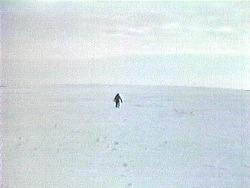
Titles by Bill Viola
- Angel's Gate
- Anthem
- Chott el-Djerid (A Portrait in Light and Heat)
- Déserts
- Four Songs
- Hatsu Yume (First Dream)
- I Do Not Know What It Is I Am Like
- Information
- Memories of Ancestral Power (The Moro Movement in the Solomon Islands)
- Memory Surfaces and Mental Prayers
- Migration
- Palm Trees on the Moon
- Reasons for Knocking at an Empty House
- Red Tape – Collected Works
- Reverse Television – Portraits of Viewers (Compilation Tape)
- Sodium Vapor (including Constellation and Oracle)
- The Passing
- The Reflecting Pool – Collected Work 1977-80
Titles with or about Bill Viola
Chott el-Djerid (A Portrait in Light and Heat)
Chott el-Djerid is a remarkable study of perception and transcendence. Viola writes that "Chott el-Djerid is the name of a vast dry salt lake in the Tunisian Sahara desert where mirages are most likely to form in the midday sun. Here, the intense desert heat manipulates, bends and distorts the light rays to such an extent that you actually see things which are not there. Trees and sand dunes float off the ground, the edges of mountains and buildings ripple and vibrate, color and form blend into one shimmering dance. In this piece, the desert mirages are set against images of the bleak winter prairies of Illinois and Saskatchewan, where the opposite climatic conditions induce a similar aura of uncertainty, disorientation and unfamiliarity. Ultimately the piece is not so much about mirages as it is about the limits of the image, i.e. at what distant point does the breakdown of normal conditions, or the lack of adequate visual information, cause us to reevaluate our perceptions of reality and realize that we are looking at something out of the ordinary — a transformation of the physical into the psychological."
Production Assistant: Kira Perov. Technical Assistance: Bobby Bielecki. Supervising Producer: Carol Brandenburg. Editor: John J. Godfrey. Produced in association with the TV Lab at WNET/Thirteen, New York.
SCREENING REQUIREMENTS for museum or gallery presentation:
The video should be presented as cinema. Projection in a dedicated, darkened gallery is strongly preferred. Accompanying floor plans and technical specifications regarding projection equipment is appreciated. Videos must be shown in original 4:3 aspect ratio, either using projector settings, as available, or pillarboxed with black masking.
Seating must be provided for the audience, and works must be shown according to a published schedule, not presented as an automatically repeating loop. Works cannot be incorporated into looping programs with other titles. Audio must be handled through a separate stereo sound system (amplifier and two speakers).
Please contact the EAI office (info@eai.org) for further information regarding monitor displays. Presentation on monitor may be permitted in certain instances, but the use of headphones or sound through built-in speakers is not permitted.







